By Roger Keil
"The imminent collapse of our civilization is standing in two key aspects of our civilization that are driving it over the edge: suburban living and the obsession with the automobile. … [M]uch of the urban structure of today all around the world being abandoned or with greatly reduced populations clustering on urban edges or in new peri-urban towns." -Antonio Zumelzu
"At the other side of the spectrum, in the receiving end of the networks supplying raw materials torn from extraction sites, we find ourselves before a world of megacities, suburbs, and various sorts of concentrated agglomerations, where the capitalist mode of production ceaselessly spawns veils upon these dense metabolic exchanges and hides them in plain sight." -Martin Arboleda
1. The Anthropocene is better named the Capitalocene. Speaking about the Anthropocene is, in the first instance, a look back at impact of past practice. One question could be: how did we end up with a warming planet? An image allegory might give us some clues. Examining the aesthetics of climate change art (for want of a better word) in a blog post, T.J. Demos contrasts the photography of Edward Burtynsky with that of Richard Misrach. Demos observes that Misrach’s image “rejects the Anthropocene’s terminological obfuscations and disavowals of culpability. Instead, Misrach’s photograph invokes the Capitalocene’s insistence on linking the current political economy to geological alteration, showing the ‘cancer alley’ of Southern oil development as part of a necropolitics of ecocide. It thereby gathers criticality and encourages viewers to participate in the growing antagonism between petrocapitalism and its environmentalist opposition—a political relationality otherwise absent in Anthropocene discourse”. A similar point is made in a striking set of sculptures called A Line in the Sand by artist Alison Ruttan “depicting the 1991 air attack by American military forces on thousands of vehicles carrying retreating Iraqi soldiers out of Kuwait. In Ruttan’s stirring reenactment hundreds of case ceramic vehicles collide with each other to create and expansive traffic jam of burnt wreckage”. With this, Ruttan moves beyond the aestheticization of the destructive force of the sub/urbanization- automobilization dynamics and offers a strategic direction which bundles these forces into a highway to hell that directly connects the oil fields with the consumption spaces back home. This is less about general culpability and more about understanding specific causalities. This is not the species at fault but its involvement in processes of capital accumulation through particular spatial forms and ways of life. Through this, we are potentially leaving the “black box” notions of “industrialization, urbanization, population, and so forth” behind and are also moving beyond a purely “consequentialist” bias in viewing the period we live in. The point here is that the Capitalocene did not start with the spread of single home subdivisions and it will not automatically end when we have densified and pedestrianized all inner cities.
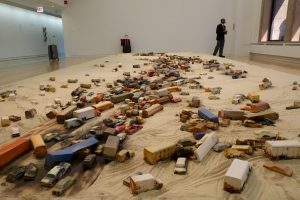 2. Still, the suburbs are arguably the main artifact of the Anthropocene. Or the other way around, the Anthropocene (or Capitalocene) has an address: it is suburbia. The suburbs (as a form, a certain idea and materiality) are identified as a major contributor to the anthropocenic conundrum at the beginning of the 21st century. In urbanization, or better suburbanization, the trajectory of the capitalocenic destruction finds a culpable actor network of political economies that produce space and, at the same time, generalizes responsibility into an unrecognizable concoction of guilt that obfuscates the processes through which those political economies work. The far-flung metabolisms and capital flows that support suburbanization are rarely revealed. The focus of planetary suburbanization is local. Still, Arboleda in his study of the remote Chilean mining town of Huasco, notes that “[t]he ecologies of the Anthropocene are … riddled with new ways of experiencing anxiety and distress, and the planetary urban fetish becomes the more ruthless, the more remote the exploited and plundered ecosystems are from the point of consumption”.
2. Still, the suburbs are arguably the main artifact of the Anthropocene. Or the other way around, the Anthropocene (or Capitalocene) has an address: it is suburbia. The suburbs (as a form, a certain idea and materiality) are identified as a major contributor to the anthropocenic conundrum at the beginning of the 21st century. In urbanization, or better suburbanization, the trajectory of the capitalocenic destruction finds a culpable actor network of political economies that produce space and, at the same time, generalizes responsibility into an unrecognizable concoction of guilt that obfuscates the processes through which those political economies work. The far-flung metabolisms and capital flows that support suburbanization are rarely revealed. The focus of planetary suburbanization is local. Still, Arboleda in his study of the remote Chilean mining town of Huasco, notes that “[t]he ecologies of the Anthropocene are … riddled with new ways of experiencing anxiety and distress, and the planetary urban fetish becomes the more ruthless, the more remote the exploited and plundered ecosystems are from the point of consumption”.
3. But it’s complicated. There is no single cause or source for this fetishization. Much more, as T.J. Demos, would have it – with reference to Jason Moore, “the crisis of climate change, …, owes not simply to a substance like oil or coal, but to complex socio-economic, political and material operations, involving classes and commodities, imperialism and empire, biotechnology and militarism, that distributes causality for environmental change beyond the problematic generalization of human species-being”. We can add to this list of complications, the production of sub/urban space as a major process through which capital accumulation “takes place” and through which it generates all manner of systemic inequalities as well climate change-relevant perturbations of major proportions.
4. So, we are moving the narrative from the consequences of anthropocenic expansion to the modalities through which we build the world in which we live. If there are going to be 10 billion humans on the earth, as one current projection holds, we know for sure that “[e]very last one of those 10 billion human beings is going to need a place to live”. Most of the future inhabitants of the earth’s crust will be living in entirely new cities and many more of those who already live in cities will move to those new, mostly suburban environments, too.
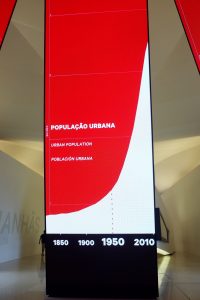 5. From this insight springs the notion that how we build cities and how those cities contribute to climate change and social injustice is a core concern in climate change adaptation and remediation efforts. Although, following Moore, “the origins of today’s crisis lie in the epoch-making transformations of capital, power, and nature that began in the ‘long’ sixteenth century” what we call sub/urbanization today is generally seen in line with industrialization , and the rates of urbanization rise sharply after the year 1800, which is also often seen as the starting date of what many consider the Anthropocene. It is exactly through the production of urban space typical for the industrial capitalist period that capital accumulates at the rates that have made it particularly aggressive in “its extraordinary reshaping of global natures”. While 19th century urbanization (that period associated with coal and steam) had devastating impacts on local, regional and global environments (including human ones), it got much worse during the century that followed, particularly during the second half. Hardly surprisingly, the “great acceleration” of climate relevant changes from the Anthropocene occurs after World War 2, a period which coincides with the Fordist-Keynesian regime of accumulation for which the “suburban solution” represented a major regulatory mechanism for both economic crisis and social unrest. Today, the suburbs are considered failures in building sustainability and contributors to social inequality. More recently, they have also been prime targets for surgical intervention in order to produce more sustainability.
5. From this insight springs the notion that how we build cities and how those cities contribute to climate change and social injustice is a core concern in climate change adaptation and remediation efforts. Although, following Moore, “the origins of today’s crisis lie in the epoch-making transformations of capital, power, and nature that began in the ‘long’ sixteenth century” what we call sub/urbanization today is generally seen in line with industrialization , and the rates of urbanization rise sharply after the year 1800, which is also often seen as the starting date of what many consider the Anthropocene. It is exactly through the production of urban space typical for the industrial capitalist period that capital accumulates at the rates that have made it particularly aggressive in “its extraordinary reshaping of global natures”. While 19th century urbanization (that period associated with coal and steam) had devastating impacts on local, regional and global environments (including human ones), it got much worse during the century that followed, particularly during the second half. Hardly surprisingly, the “great acceleration” of climate relevant changes from the Anthropocene occurs after World War 2, a period which coincides with the Fordist-Keynesian regime of accumulation for which the “suburban solution” represented a major regulatory mechanism for both economic crisis and social unrest. Today, the suburbs are considered failures in building sustainability and contributors to social inequality. More recently, they have also been prime targets for surgical intervention in order to produce more sustainability.
6. Sub/urbanization is contradictory as Hodson and Marvin remind us: “Critically, cities are often simultaneously represented as being: significant contributors to the ‘cause’ of climate change, where urban areas and their inhabitants may be responsible for up to 75% of global energy consumption and carbon emissions; as foremost amongst the ‘victims’ of climate change, particularly the vulnerable coastal megacities of the global south; and as key sites of ‘innovative response’, such as through the actions of the representatives of large cities in the C40 network”. What seems a truism for cities now, is denied to the suburbs, though: while suburbia and suburbanites are definitely considered to be among the chief ‘causes’, they rarely get included in the catalogue of the sites or origins for ‘innovative responses’ to the problem. They remain firmly on the debit side of the anthropocenic equation.
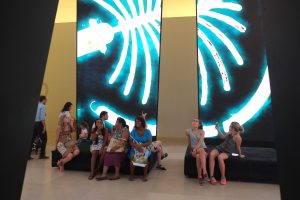 7. Like Erik Swyngedouw and Maria Kaika, I am “not so much concerned with the question of nature IN the city, but rather with the urbanization OF nature, i.e. the process through which all types of nature are socially mobilized, economically incorporated (commodified), and physically metabolized/trans¬formed in order to support the urbanization process” but in particular in how the suburbanization of nature plays a part in both the problem constellation and in the modalities of governance and politics from which solutions are sought. The suburbs as a place of alienation and separation from nature, therefore, are to be understood themselves as a place of a larger chain of activities that constitute the extended urban political ecology. This is where the search for planning solutions has to start.
7. Like Erik Swyngedouw and Maria Kaika, I am “not so much concerned with the question of nature IN the city, but rather with the urbanization OF nature, i.e. the process through which all types of nature are socially mobilized, economically incorporated (commodified), and physically metabolized/trans¬formed in order to support the urbanization process” but in particular in how the suburbanization of nature plays a part in both the problem constellation and in the modalities of governance and politics from which solutions are sought. The suburbs as a place of alienation and separation from nature, therefore, are to be understood themselves as a place of a larger chain of activities that constitute the extended urban political ecology. This is where the search for planning solutions has to start.
8. Suburbanization is a process of city building and re-building at the metropolitan edge including processes of post-suburbanization generating new suburban ways of life that are central to understanding the link of planetary sub/urbanization and the Anthropocene. It is in the everyday behaviour of the suburbanites that the “suburban problem” finds its most common expression. They are part of an extended urbanization serving a more central economy and being left out of the master narrative of the central urban economies that matter in urbanist discourse. Yet, the suburbs, major part of the operational landscapes of extensive urban society, are not inhabited by immobilized suburbanites whose only political reflex is to defend their privileges.
9. Critical urban studies foreground the central place as the hub of metabolisms and the location of relevant politics and planning. The last mile, premium network spaces, financial institutions bankrolling the water system, knowledge production, etc. all represent urban political ecology (UPE) as spatially central. Central places, urban centres are privileged as locations for meaningful planning interventions. Instead, perhaps, it may be useful to expand such political and planning geographies to the arterial street, the greenbelt, the mall, the suburban neighbourhood, the regional transportation hub as places aspiring to centrality and worthy of our planning activities.
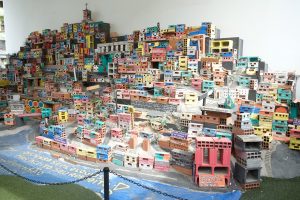 10. Urbanist discourse (including more mainstream urban environmentalism) views everyday suburbanism as the structural source of climate change and environmental destruction here and there, near and far and there is much truth in that. But it must also be seen as a site and terrain of political ecological and planning action. An important aspect of this problematique is the debate on density and infrastructures. We can posit that between the exostructures of the global urban political ecologies that sustain both mining towns like Huasco and the suburbs of Toronto (for example) and the people as infrastructures, there is real life, politics and potential for change. The suburbs are not remnant dead spaces in the shadow of the dynamic and creative urban quarters where planning is allegedly “naturally” at home. This means looking for the suburban between the extension and the dictates of the superblock.
10. Urbanist discourse (including more mainstream urban environmentalism) views everyday suburbanism as the structural source of climate change and environmental destruction here and there, near and far and there is much truth in that. But it must also be seen as a site and terrain of political ecological and planning action. An important aspect of this problematique is the debate on density and infrastructures. We can posit that between the exostructures of the global urban political ecologies that sustain both mining towns like Huasco and the suburbs of Toronto (for example) and the people as infrastructures, there is real life, politics and potential for change. The suburbs are not remnant dead spaces in the shadow of the dynamic and creative urban quarters where planning is allegedly “naturally” at home. This means looking for the suburban between the extension and the dictates of the superblock.
11. The suburban is not a peripheral or marginal place (or topic). Large majorities of urban society now claim the suburban as home, workplace or landscape of jouissance. The ‘centralities’ of these landscapes for today’s urban political ecologies need to be one starting point for the performativity of urban and social change (perhaps radical incrementalism of sorts). Just as mining and logging sites are part of the invisible operational landscapes of planetary urbanization, the suburbs with their dumps and warehouses, their land uses that have been expelled from a place of centrality, too. Everyone sees the airport terminals but nobody sees the aerotropolis. Those aspects of the suburban remain part of the “urban uncanny”.
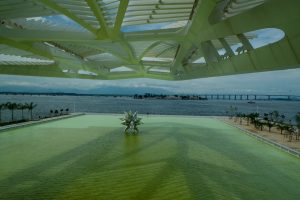 12. The view finally extends from the capitalocenic past into an uncharted future. In Rio de Janeiro’s newly opened Museum of Tomorrow, built by Santiago Calatrava, an exhibit makes the visitor move through the histories of the cosmos and the geographies of the Anthropocene to the future we humans might envision together. In the crescendo-style build-up towards the state of crisis we find ourselves in at this stage of the Anthropocene, skyscrapers give way to a display of Dubai’s Palm, an artificial suburban strip gained from the sea. From there, the visitor moves quickly towards the end of the building where it juts out over the bay along which Rio’s asfalto and favela neighbourhoods expand into the plains and climb up the hills. Staring into the glaring sun, there is little to see that gives clues how to manage Tomorrow. Except, perhaps, that a politics of the Anthropocene might have to be reimagined in those global suburbs that now house the majority of us and where the Capitalocene derives its metabolic dynamism.
12. The view finally extends from the capitalocenic past into an uncharted future. In Rio de Janeiro’s newly opened Museum of Tomorrow, built by Santiago Calatrava, an exhibit makes the visitor move through the histories of the cosmos and the geographies of the Anthropocene to the future we humans might envision together. In the crescendo-style build-up towards the state of crisis we find ourselves in at this stage of the Anthropocene, skyscrapers give way to a display of Dubai’s Palm, an artificial suburban strip gained from the sea. From there, the visitor moves quickly towards the end of the building where it juts out over the bay along which Rio’s asfalto and favela neighbourhoods expand into the plains and climb up the hills. Staring into the glaring sun, there is little to see that gives clues how to manage Tomorrow. Except, perhaps, that a politics of the Anthropocene might have to be reimagined in those global suburbs that now house the majority of us and where the Capitalocene derives its metabolic dynamism.
These theses were presented at the panel Planning in the Anthropocene at the Faculty of Environmental Studies, York University on March 22, 2016.
They are based on a forthcoming chapter in a book on the topic edited by Henrik Ernstson and Erik Swyngedouw. This work was first presented at the conference Anthro-Obscene and Democratic Practices in Stockholm, September 2015.

